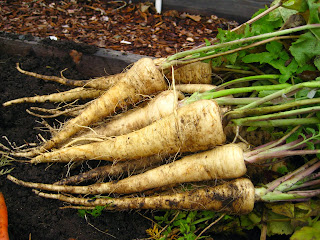As I mentioned in my last post, I dug up the last of my root crops the weekend before last, right before the ground froze. One of those crops is parsnips. I've grown parsnips for years and can't imagine a garden -- or winter kitchen -- without them.
Anytime I give a garden talk and mention that I grow parsnips, I invariably see a few wrinkled noses. So now it's time for me to take on a "Mom" role and say, "Don't tell me you don't like them without trying them!" (you used to say that to your kids, right?)
Parsnips look like white carrots on steroids. They tend to have quite sturdy roots. But the similarity ends there. They don't really taste like carrots because they have a sweet, nutty taste. I think parsnips are at their best when roasted in the oven.
I've often roasted them in large chunks with other root vegetables like beets, onions and carrots. A drizzle of olive oil and balsamic vinegar adds a lovely flavor. But there are many other ways to prepare them.
One of my favorite recipes is a potato-parsnip gratin where you thinly slice equal amounts of each, then layer them in a shallow casserole dish along with slices of onions. You pour a medium white sauce over everything, top it with shredded Swiss cheese, and bake it in the oven. Mm-mmm! (I don't know where the recipe came from so can't print it here, but if you'd like it, just drop me a note at inthegarden@live.com.)
Another recipe I plan to try this Thanksgiving is mashed parsnips and potatoes that sounds delicious. You use equal proportions of both veggies, cook them in boiling water just like you would regular for mashed potatoes from scratch, then puree them while adding in melted butter, chopped herbs, and salt and pepper. It should make a fabulous side dish!
So how do you grow parsnips anyway? They are related to carrots so the cultural requirements are the same. I plant them in rows rather than broadcasting the seeds in a block because it's much easier to thin the seedlings later. I sow the seeds in early spring, about 1 inch apart. I water them in, then cover the row with a board (usually a spare 2x4) which prevents the soil from forming a crust on the surface, which makes it hard for the seedlings to break through. I remove the board after a week.
Once the seedlings are about 3 inches tall, I thin them 3 to 4 inches apart. That's the one difference from growing carrots which can be spaced a little more closely. However, parsnips tend to be 2 to 3, or even 4 inches in diameter so they need a little more space. And that's it! You just water them through the summer and early fall, and harvest them before the ground freezes.
Store them in a dark, cool and somewhat moist environment. I usually put them into plastic bread bags and store them in our refrigerator's produce drawer. Root cellars work great, as do bins of dampened sand that are either in a cold environment like a garage or sunk into the ground.
So give parsnips a try! You can start by trying some from the store and go from there. I'm hoping you'll pick up some seeds and grow them next year.
